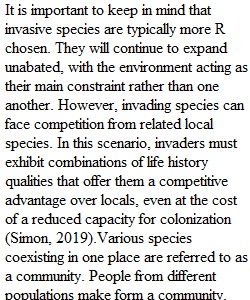


Q Complete the following and submit the Word document by midnight Sunday. Remember to include complete citations for all sources used to answer each question. 1. Are most invasive (exotic) species K-selected or r-selected species? Explain your choice and why that makes sense in terms of their ecological success. 2. Briefly define a community and an ecosystem and describe how the two are interrelated. 3. Which of the following levels of organization are in order, from simplest to most complex. a. population, organism, community, ecosystem b. community, ecosystem, population, organism c. organism, community, population, ecosystem d. population, ecosystem, organism, community e. organism, population, community, ecosystem 4. Mosses growing on bare rock will eventually help to create soil. These mosses are involved in ___ succession. a. primary b. secondary c. tertiary 5. If a farmer sprays a pesticide onto a field and kills half of the insect pests, he has caused a reduction in________. a. field capacity b. carrying capacity c. population size d. More than one of the above 6. What type of survivorship curve would you expect for a plant species in which only a few seeds are produced and most of these survive to produce adult plants? a. type I b. type II c. type III 7. An ecological niche is an organism's_______ in an ecosystem. a. location b. habitat c. resources d. function 8. No matter how rapidly populations grow, they eventually reach a limit and begin to stabilize. This is called the ______________. 9. Unicellular algae live in the tissues of coral animals. The algae provide food for the coral, while the coral provides a stable home for the algae. This is an example of a. Parasitism b. Commensalism c. Mutualism 10. The vast majority of energy taken into an ecosystem is____________. a. converted into biomass by plants. b. utilized by secondary consumers. c. lost as heat. d. used by the primary consumers. e. concentrated in the decomposers. 11. A farmer is using an insecticide to treat his crops. While most insects do not survive their first exposure to the insecticide some have a gene that enables them to survive. When these survivors reproduce they will likely pass along this resistance to their offspring. This results in an increase in numbers of the insects over time. Which of the following processes applies to this survival? a. cloning b. mutation c. natural selection d. genetic engineering 12. What is the ecological relationship between insects and crops? a. mutualism b. competition c. predation 13. Sea anemones growing on the backs of crabs without damaging the crabs are an example of a. Parasitism b. Commensalism c. Mutualism 14. Which of these is a population density-independent regulating factor? a. Competition b. Predation c. Size of population d. Weather e. Resource availability 15. Producers are_________. a. Autotrophs b. Herbivores c. Omnivores d. Carnivores 16. If biological magnification occurs, the ___ will have the highest levels of toxins in their systems. a. producers b. herbivores c. primary carnivores d. top carnivores 17. Given the amount of sunlight that hits the plants on our planet, and the ability of plants for rapid growth and reproduction, how come we aren’t all hip deep in dead plants? ________________________________________ The following Grading Rubric will be used to score your homework: Questions Expectation Points 1 Demonstrates an understanding of the characteristics of r- and K-selected species. 0-3 2 Correctly defines the two terms and explains how the two are related. 0-3 3-16 Demonstrates an understanding of ecological concepts. 0-14 17 Applies the knowledge of trophic levels in a real-world situation. 0-3 TOTAL {{{{{{{{{{ 23 pts PreviousNext
View Related Questions